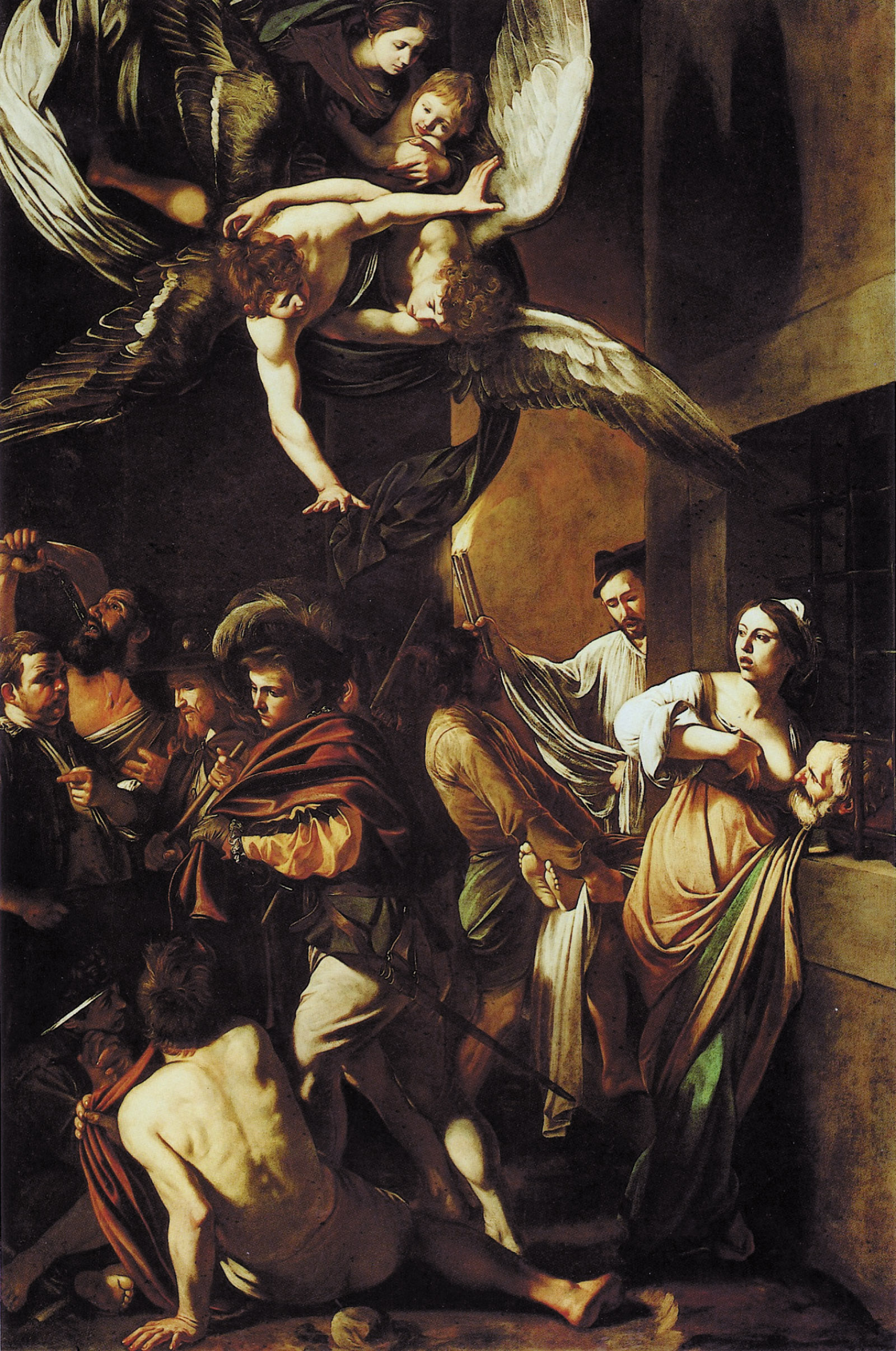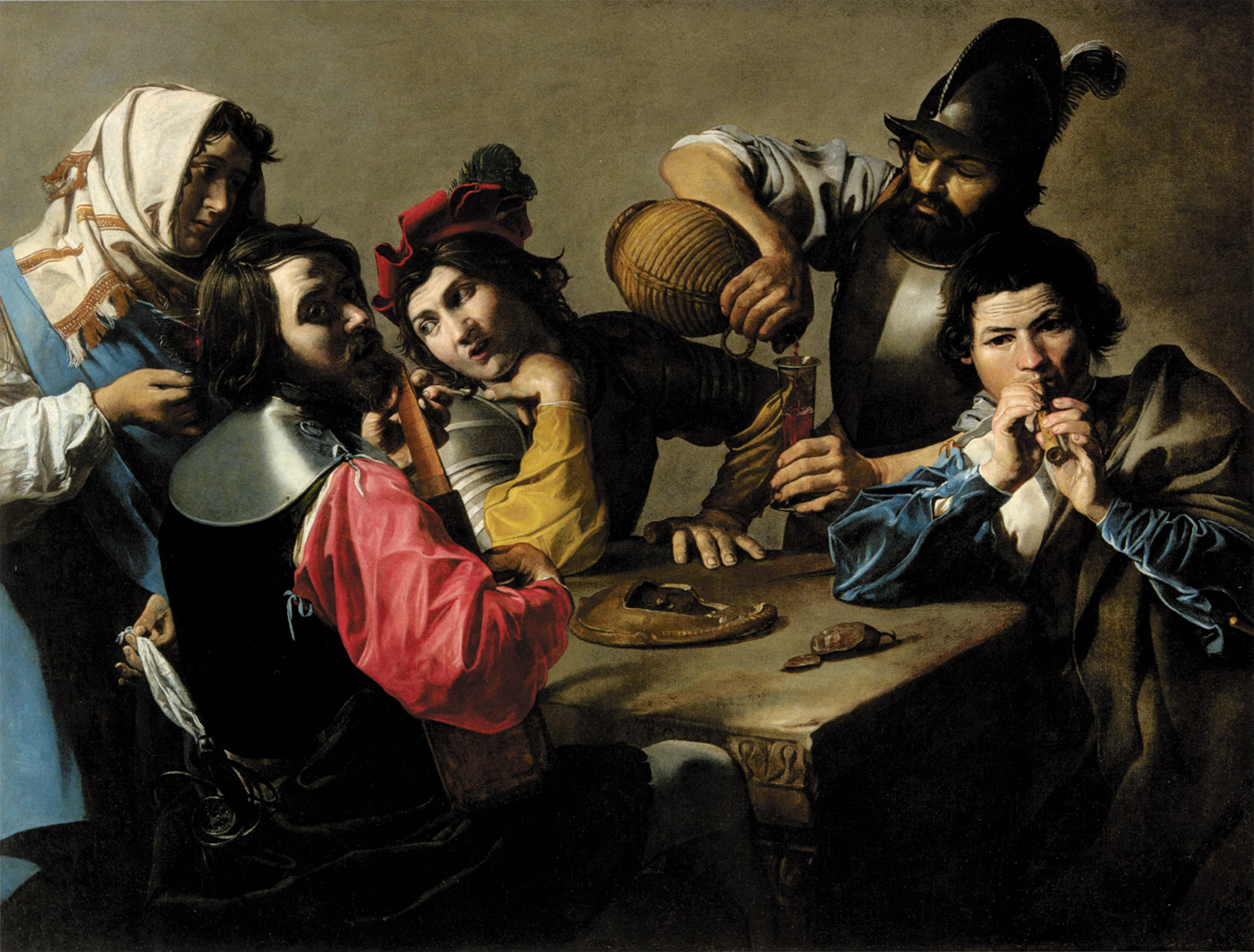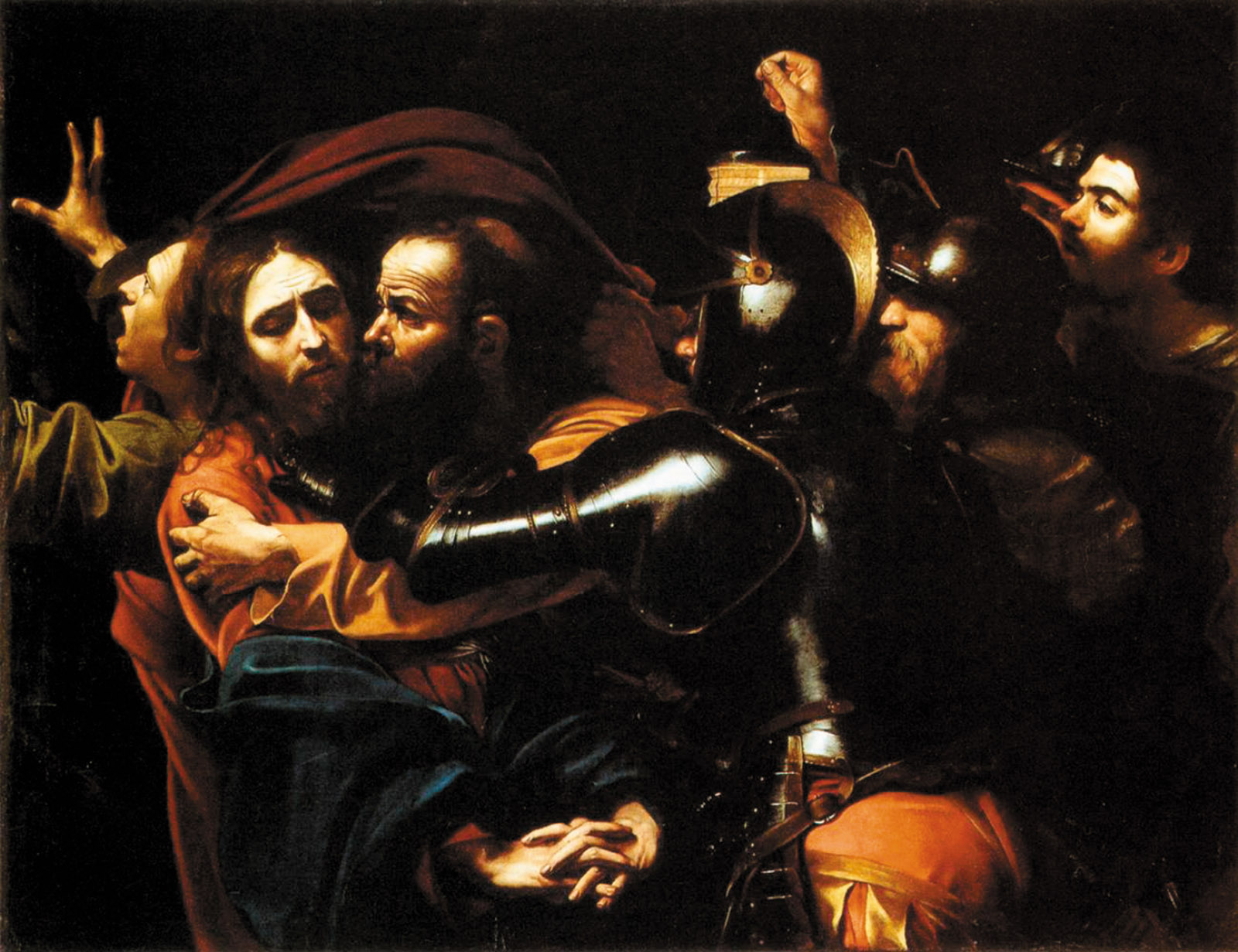Two museums, London’s National Gallery and New York’s Metropolitan Museum of Art, mounted exhibitions in the fall of 2016 with the title “Beyond Caravaggio,” proof that the foul-tempered, short-lived Milanese painter (1571–1610) still has us in his thrall. The New York show, “Valentin de Boulogne: Beyond Caravaggio,” concentrated its attention on the French immigrant to Rome who became one of Caravaggio’s most important artistic successors. The National Gallery, for its part, ventured “beyond Caravaggio” with a choice display of Baroque paintings from the National Galleries of London, Dublin, and Edinburgh as well as other collections, many of them taken to be works by Caravaggio when they were first imported from Italy.
In Stratford-upon-Avon, meanwhile, the Royal Shakespeare Company produced a new play about the artist, Anders Lustgarten’s The Seven Acts of Mercy, focused on the monumental painting of the same name in Naples that also provides the focus for Terence Ward’s moving nonfiction book The Guardian of Mercy. In November 2016, Caravaggio’s radiant Basket of Fruit moved to Rome from Milan to provide the focus and the poster image for yet another exhibition, “The Origin of Still Life in Italy” at the Borghese Gallery (which boasts its own incomparable collection of Caravaggio’s work). And yet, in the face of so much exposure, Michelangeo Merisi da Caravaggio remains a painter of infinite suggestion and infinite mystery.
Letizia Treves, the National Gallery’s new curator of Baroque painting and the creator of the delightful “Beyond Caravaggio” exhibition, reminds us how few people in the mid-nineteenth century had ever seen a real painting by the artist. Many of those who did were unimpressed. John Ruskin called him “the ruffian Caravaggio,” “a worshipper of the depraved.” In general, Victorian Britons preferred the orderly sunlit world of the Italian Renaissance to the dark, chaotic Baroque, with its suffering saints and grimy beggars. It is not so surprising, then, that British collectors bought canvases by Antiveduto Gramatica, Giovanni Baglione, and Bartolomeo Manfredi in the belief that they were Caravaggio originals: dramatic contrasts of light and shadow, overt religious imagery, and gritty, louche scenes from everyday life seemed to authenticate them as much as an autograph (in fact, Caravaggio signed only one of his paintings, The Beheading of John the Baptist in Malta).
Sometimes, as in the case of Giovanni Baglione’s Ecstasy of Saint Francis, exported from England as a Caravaggio in 1947, there were good reasons to be confused about the artist’s identity: Baglione was trying his utmost to paint like Caravaggio, using a theme that Caravaggio had already made famous. On the other hand, some works painted by Caravaggio, like the Dublin Taking of Christ, have spent decades languishing under layers of grime and attributions to artists like Velázquez, Murillo, and the Dutchman Gerrit van Honthorst, who visited Rome before returning to Utrecht and becoming famous for his honey-toned paintings of candlelit interiors.
Caravaggio, as “Beyond Caravaggio” makes clear, was not the only accomplished painter of his day. Seventeenth-century Italy was a veritable magnet for ambitious artists, especially the great cities of Rome and Naples. The versatile Orazio Gentileschi was surely responding to Caravaggio’s Rest on the Flight to Egypt with his own startling composition on the same theme. In front of a ruined building, an exhausted Joseph has flopped down asleep on their baggage while Mary, seated on the ground, nurses the infant Christ. Behind the wall of the ruin, their wise-eyed, patient donkey rears its noble head, framed against a gorgeous indigo cloudscape (see illustration in Colm Tóibín’s article in this issue).
Gentileschi’s ability to portray fur in oils is rivaled in this exhibition only by the Neapolitan painter usually known as the Master of the Annunciation to the Shepherds—art historians cannot agree whether he was Bartolomeo Bassante or Juan Dó. An Annunciation to the Shepherds from Birmingham shows that the Master had a special talent for painting shaggy sheep for feudal lords who drew their income from vast flocks, driven over the breadth of southern Italy by just such brutally impoverished peasants as the tired, ragged men who can barely muster the strength to listen to the angels. Jusepe de Ribera, the Spaniard who spent most of his career in Naples, can make oil paint suggest any texture under the sun. His Martyrdom of Saint Bartholomew shows the elderly man tied up and ready to be flayed by a thug, with the saint’s loose, dry skin, wispy hair, wiry beard, and glittering eye all evoked to perfection.
Ribera features prominently in the Met’s presentation of Valentin de Boulogne, the French bon vivant who arrived in Rome about a decade after Caravaggio’s death and who fully merits his own show and his own place in the history of Baroque painting. In a series of groundbreaking essays, Keith Christiansen, Annick Lemoine, Patrizia Cavazzini, Gianni Papi, and Jean-Pierre Cuzin argue that the young Ribera must have worked directly with Caravaggio, and that he and Valentin became the two most accomplished painters in the master’s “realist” tradition—which, like Caravaggio’s, is not so realist after all. Several of the pieces of ancient sculpture that Valentin portrays in his seedy Roman taverns are his own inventions; on the other hand, as Christiansen notes, the up-front immediacy of his Judith and Holofernes makes Caravaggio’s version of the same story look positively mannered. Valentin’s blues are a wonder in themselves, nowhere more marvelous than on the shimmering coat of the father in his Return of the Prodigal Son.
Advertisement
Pointing the way “beyond Caravaggio” are several paintings by the master himself, which show that his own technique can be surprisingly uneven. Boy Peeling Fruit, exhibited in London as a youthful work, is not universally accepted as an original, because the painting is so clumsy in so many places. The boy’s face sinks back behind the left wing of his weirdly obtrusive collar, which seems to have been painted after the face, and with thicker pigment. Beneath his open shirt, the youth’s chest lacks any trace of modeling: no shadow, no sign of ribs, or muscle, or breastbone, nothing but a wash of pale flesh-colored pigment. The fruits in front of him, on the other hand, are beautifully succulent, forerunners of that sublime Basket of Fruit from Milan, in which the apples may be spotty and the grape leaves worm-eaten, but the yellow of the background is as full of light as a ray of sunshine.
Caravaggio’s more mature works show some of the same technical deficiencies as Boy Peeling Fruit, the anatomy of the male torso foremost among them. Saint John the Baptist in the Wilderness (on loan from the Nelson-Atkins Museum of Art in Kansas City) captures our attention with his concentrated scowl, but he has a shapeless belly and oddly proportioned legs, and always did: a seventeenth-century copy of the painting in Rome’s Doria Pamphilj Gallery shows that the saint’s torso was always an ambiguous zone, its lack of definition never entirely finessed by some strategically placed shadows. Twenty years after Caravaggio’s death, Valentin de Boulogne would paint his own version of Saint John the Baptist in the Wilderness, taking special pains to articulate every one of the Baptist’s perfectly toned abdominal muscles—a pungent criticism of the master wrapped up in a reverent tribute.
But most of all, the Caravaggio originals in London’s “Beyond Caravaggio” demonstrate why the painter exerted such an overwhelming influence on patrons and colleagues alike, and why he is so passionately loved today. He can paint beautifully most of the time. He produced marvelous compositions of light beaming forth from the darkness, covered his canvases with luminous whites, full-blooded reds, velvet blacks, but above all, especially later in his career, he painted with restraint, and taste, and a gigantic, compassionate heart.
The restraint shows when we compare his work with that of his admirers. If the young Caravaggio painted several versions of a boy with fruit as a way of advertising his skill at both still life and the human figure, his pupil and follower Francesco Boneri (nicknamed Cecco del Caravaggio—“Caravaggio’s Frankie”) painted a red-haired musician surrounded by a bushel of fruit, cheese, bread, gourds, two glass flasks encased in nets, a hanging head of garlic, a glass vase full of water, and a violin—splendidly painted, like the sitter’s plume, shirt, and brocaded vest, but he could have proven his skill just as cogently with half as many objects. Caravaggio’s painting of Doubting Thomas showed the disciple sticking his index finger into the side wound of Jesus, a startling image already, but discreetly done compared with the way that Giovanni Antonio Galli, called Lo Spadarino (“Little Swordsman”), gives us Christ head-on, staring us down as he spreads the wound wider himself, daring us to play Saint Thomas with our eyes instead of our finger.
Caravaggio painted two versions of a plumed dandy, barely beyond adolescence, who gazes into the deep brown eyes of a pretty gypsy girl as she pretends to read his palm and slides a gold ring off his finger. Bartolomeo Manfredi portrays the same scene, but adds a second gypsy girl to steal the boy’s purse out of his pocket and a male crook who lifts a chicken out of the first gypsy’s tote bag in a witty crescendo of thievery. Valentin de Boulogne made a veritable specialty of painting such intricate chains of deception, lightened by piercing flashes of color or a glint of metal, melancholy reminders that we are all eternally gullible, whether we admit it or not. And yet the original idea for each of these paintings, what the artists would have called the invenzione, was Caravaggio’s, and they painted, ultimately, in ways inspired by Caravaggio’s style.
Advertisement
Often the most effective developer of Caravaggio’s ideas was the man himself. He was, after all, his own most penetrating critic.
The National Gallery owns one of two versions of Caravaggio’s Supper at Emmaus, an episode from the Gospel of Luke that took place immediately after the crucifixion, death, and disappearance of Jesus. Two disciples were slinking dejectedly away from Jerusalem when they met a wayfarer on the road who asked why they looked so unhappy. As they poured out their story, he replied that all these events had been predicted by the Hebrew prophets, “and beginning at Moses and all the prophets, he expounded unto them in all the scriptures the things concerning [the Messiah].”
When the three reached the village of Emmaus, the two disciples invited the stranger to dine with them, and when he took their loaf of bread and broke it, two things happened: they suddenly recognized that their traveling companion was Jesus come back from the dead, and he vanished. Afterward, “they said one to another, Did not our heart burn within us, while he talked with us by the way, and while he opened to us the scriptures?” Caravaggio presents a young, beardless Jesus at the table, as unrecognizable to us as he has been to his companions until this very moment—while to the solicitous innkeeper who serves them, the young man is still just a customer. This Supper at Emmaus is a work of early maturity, painted in 1601, with shiny, fresh colors and virtuoso turns like the fruit basket balanced on the table’s edge.
A version of the same episode from 1606, now in Milan, is more subdued in its colors and gestures, concentrating all its attention on the infinitesimal margin between the hand of Jesus and the hand of his disciple, not quite touching because they inhabit two different orders of reality, but close enough to charge this tiny space with significance: for a blessing from God to man will cross this gap like a spark. Five years after the first Supper at Emmaus, Caravaggio’s special effects seek to electrify the soul rather than simply divert the eye.
The Dublin Taking of Christ, commissioned in 1602, draws its composition from an engraving by Albrecht Dürer (pictured in the excellent catalog) and possibly ancient Roman sarcophagi, yet what we register is not the erudite details of an exceptionally learned invenzione, but the extreme emotions on three faces pressed in close together: Judas the betrayer as the depth of his crime dawns on him even as he delivers his perfidious kiss, Jesus shivering as an armored fist clamps down on his mantle and beard, and the beloved disciple John screaming as he turns away in horror. In an emergency like this, who can think about painting?
That is the power of a real Caravaggio. Sometimes, it simply changes your life. Terence Ward’s The Guardian of Mercy tells the contemporary story of the man who was delegated to watch over The Seven Acts of Mercy in the early 1990s, when a new mayor tried to take back the streets from the mafia and make the city appealing to tourists again. A public employee who had worked for fifteen years in the Department of Sanitation, Angelo Esposito, reassigned as a museum guard, became increasingly enthralled by Caravaggio’s large canvas, in those days a hidden treasure tucked away in the ancient heart of Naples, along a street laid out by Greek colonists in the sixth century BCE. The painting was commissioned in 1607 by the Pio Monte della Misericordia, a group of young aristocrats committed to helping the poor in a city that has always been marked by dramatic discrepancies of income. The Pio Monte still exists, and so does the yawning need; Ward and his wife, Idanna Pucci, came to know some of the descendants of the confraternity’s original founders.
Caravaggio had been asked to portray what their Catholic creed called the Seven Works of Mercy: feeding the hungry, clothing the naked, visiting the sick, visiting prisoners, giving drink to the thirsty, giving shelter to strangers, and burying the dead. The patrons’ original plan was to devote a single painting to each good work for their graceful circular chapel, but Caravaggio cleverly combined all seven deeds in a single Neapolitan street scene. The resulting panel became the chapel’s altarpiece.
Naples in the seventeenth century was one of the world’s most populous cities, and one of the most crowded, its towering tenements packed in among the palaces of the aristocracy and huge Gothic churches, soon to be covered with the opulent Baroque ornament we see today. Caravaggio portrays the intersection of two Neapolitan alleys much as it must have been in his era, when thousands of people lived on the street all year round. Velvet-clad nobles with flashes of lace at collar and cuffs move through a thick crowd of people: one, in a plumed hat, hands his cloak to a naked, lame beggar (thus visiting the sick and clothing the naked in a single action). Another, slightly older nobleman shows a weary red-bearded pilgrim the way to shelter. Just behind them, a brawny figure drinks water from the jawbone of a donkey, just as Samson did in the Bible.
As in The Taking of Christ and The Supper at Emmaus, Caravaggio mixes the remote past of the gospel story with the immediacy of life here and now. In the painting’s middle ground, where the two alleys meet, a servant pulls along a corpse in a winding sheet as a torch-bearing priest offers a prayer. In the foreground, an elderly prisoner at his barred window and a young woman standing in the street act out the ancient story of “Roman Charity”: sentenced to starve in prison, old Cimon survived because his daughter Pero, a nursing mother, could slip by the guards empty-handed and feed him on the sly. In the ancient story, Cimon’s captors set him free when they discover the depth of Pero’s devotion.
Caravaggio’s Pero may be performing two works of mercy (feeding the hungry and visiting prisoners), but she is also breaking the law, however unjust that law may be. The furtive look on her face must have been all too common in Naples under the Spanish viceroys. Their dread courthouse and prison, Palazzo dei Tribunali, loomed only two blocks away from the chapel of the Pio Monte. It would have been perfectly clear to everyone in Naples that Caravaggio’s Cimon is sequestered in a real place, charging this religious painting with a clear political message. The viceroys in Naples faced perpetual hostility from the local nobility, who hated them passionately and rebelled in a thousand different ways. Neither elite cared much about the poor, an indifference the volunteers of the Pio Monte, and Caravaggio with them, tried to combat in actions and art.
Into this dark, cruel alley, then, two angels burst in a flutter of wings, with the Christ Child and the Virgin Mary right behind them, looking down on the tangled scene from a kindly but unfathomable distance, affirming the works of mercy that shine forth from the enveloping darkness. The beggar is still crippled, the prisoner incarcerated, the corpse deceased. But the pilgrim has found his way to shelter for one more night, the beggar will rest warmly on the streets where he makes his home, Samson is no longer thirsty, Cimon will live another day, and the Pio Monte will be back at work tomorrow.
In many ways, for Angelo the guard, Caravaggio’s Naples differs little from his own. The streets, the very same ancient Greek streets, can still be merciless: the Camorra (the Neapolitan Mafia) and drugs have replaced the regime of the viceroys, and the gulf between wealth and poverty still gapes wide. The Guardian of Mercy describes this complicated city with accuracy and empathy, including the colossal disappointments that followed on Naples’s brief resurgence in the 1990s. The painting and its emphatic message of compassion at all costs eventually inspire Angelo to perform his own work of mercy when his life reaches a crisis point. Thus this unusual and poignant book insists that Caravaggio’s paintings still call upon us to think and act, not just to look on passively, and in laying down this challenge, as Ward argues, the artist extends a compassionate hand to his viewers across the centuries.
Caravaggio’s compassionate hand is made literal in the final scene of Anders Lustgarten’s The Seven Acts of Mercy, which focuses on the same painting and ties it just as emphatically to the dark recesses of contemporary life, this time a council flat in Liverpool in 2016 rather than the streets of Naples in 1607. The play, commissioned for the Royal Shakespeare Company and performed in Stratford-upon-Avon this past fall, is alternately brilliant and maddening: brilliant for its performances and for the way it illuminates a marvelous, militant painting; maddening because Caravaggio, a Milanese gentleman who clung ferociously to the bottom rungs of the aristocratic ladder, has become a man of the people who speaks and acts like a Liverpudlian yob, spouting Marxist social philosophy amid his endless stream of obscenities.
Nonetheless, Lustgarten, and an impassioned Patrick O’Kane as Caravaggio, succeed in conveying the artist’s heroic fury at the world and his no less heroic compulsion to shoulder its sorrows. The action shifts between Caravaggio’s struggles with the painting, which stands at the back of the stage and gradually takes shape as the play progresses, and the life struggles in Bootle, Merseyside, of an elderly leftist grandfather (Tom Georgeson) facing eviction from his home along with the sensitive grandson (T.J. Jones) who shares his passion for Caravaggio’s art. They know the painter only from a beloved book, an encyclopedia of art, but in the play Caravaggio’s enormous canvas provides a constant, and touching, backdrop.
The grandson’s attempts to carry out, and document, the seven works of mercy in contemporary working-class Britain collide with realities every bit as violent as those of Caravaggio’s Naples: in Liverpool, a man who refuses to sell his flat to gangsters is beaten to death; in Naples, Caravaggio’s model, the prostitute Lavinia (Allison McKenzie), is put back in her place by the sfregio, a brutal slash across the face that was all too common in seventeenth-century Italy (by the same means the sculptor Gianlorenzo Bernini disfigured his aristocratic lover, Costanza Piccolomini, when she took up with his brother Luigi).* As Caravaggio’s patron, the Marchese Giovanni Battista Manso, Edmund Kingsley radiates the nobility that the tortured painter could never attain in life (both real life and Lustgarten’s staged life) but found in his infinitely magnanimous art.
This tragic play has its moment of high comic relief when Leo, the grandfather, compares the British political scene to its football clubs, reaching a climax in:
Liverpool Football Club as New Labor. Sold out, bloated, bombastic, delusional, a million miles away from the working-class roots and values it pretends to espouse. A prisoner of its own hubris, cowardice, and ineptitude. In many ways the most disgusting of the lot.
Caravaggio, who killed the thug Ranuccio Tomassoni on a tennis court, would have understood. When the seventeenth-century painter holds Leo’s hand on his deathbed, he cements a connection that the entire audience can understand and share. That hand has been extended to us as well, through the magnificent picture that reaches completion by the end of the evening.
In his introduction to the published script of The Seven Acts of Mercy, Anders Lustgarten writes: “The first time I saw The Seven Acts of Mercy, in the Pio Monte in Naples, I knew I wanted to write a play about it: its generosity, its complications, its aggressive, violent compassion.” In the preface to The Guardian of Mercy, Terence Ward responds to Caravaggio’s painting in strikingly similar ways:
In a city that survives on a knife edge between cruelty and grace, the acts of mercy still resonate today with universal meaning, as relevant now as when the artist brushed his oils onto the canvas four centuries ago.
Technically, Jusepe de Ribera is a phenomenal painter, at least as good as Caravaggio, but when he shows people in pain, like Saint Bartholomew on the verge of flaying, we can feel his distance from the event. The Master of the Annunciation to the Shepherds seems to keep the same distance from his filthy subjects. But when Caravaggio shows a humble disciple or an innkeeper, he shows them as full human beings. When he shows suffering, he stands his ground rather than shrinking back. Along with the disciple who screams as Jesus is dragged off to prison and Jesus himself feeling both the kiss of Judas and the blow of Pilate’s thug in a single instant, he paints himself right into The Taking of Christ and its profound tragedy: the figure on the far right of the painting is the artist himself, holding up a lantern. That is what makes Caravaggio different, and so dearly loved.
This Issue
May 11, 2017
Dover and Out
Trump’s Travel Bans
-
*
See my “Bernini: He Had the Touch,” The New York Review, June 4, 2015. ↩






